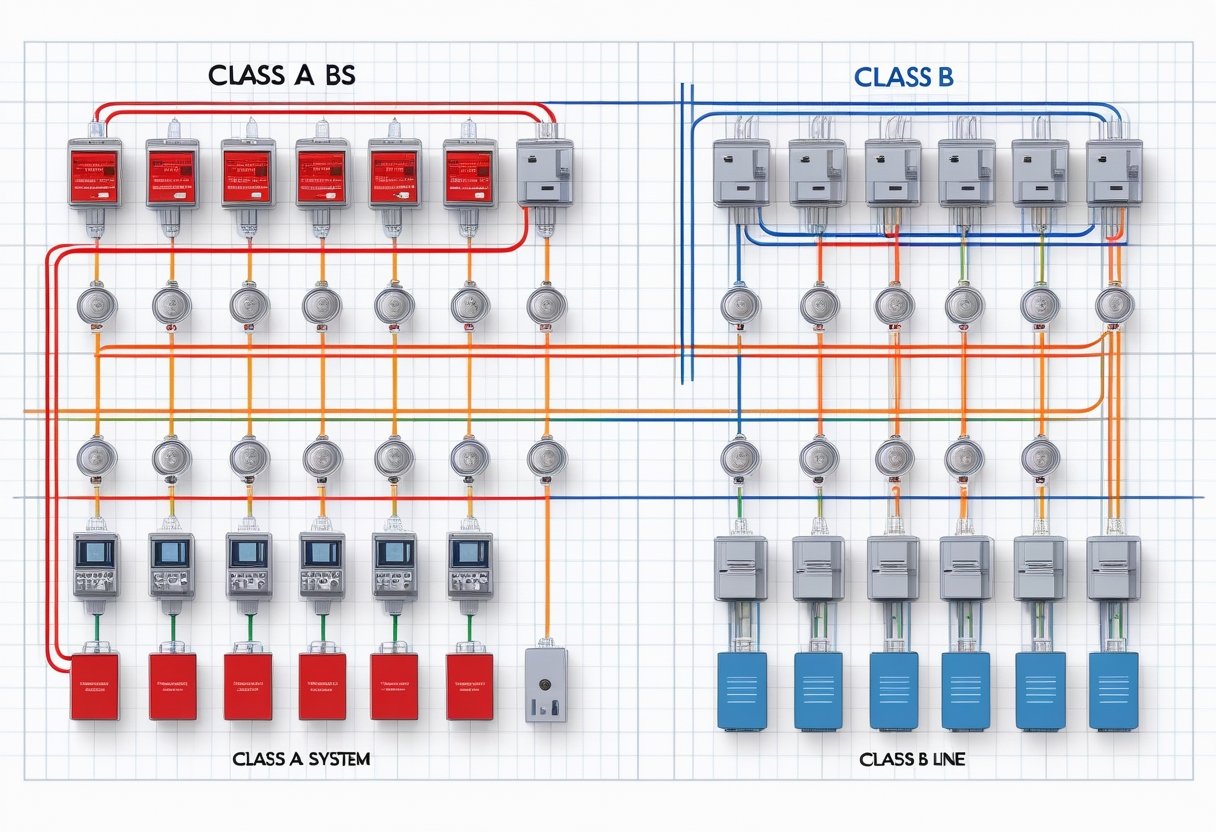When it comes to fire alarm systems, understanding the differences between Class A and Class B wiring is essential for ensuring safety and reliability in your property. Class A systems offer enhanced redundancy, allowing your fire alarm network to remain operational even if an issue arises, while Class B systems are more straightforward but can suffer from limitations if a wire is compromised.
In the greater Houston area, your choice of fire alarm wiring can significantly impact how effectively your system detects and communicates alarms. Class A wiring is designed to provide a continuous loop, meaning that if one part of the system fails, the signal can still travel through another path, ensuring that the alarm remains active. On the other hand, Class B wiring connects devices in a series, which can lead to a complete system failure if a single break occurs in the circuit.
As you consider which fire alarm system best suits your needs, you’ll want to weigh these factors carefully. Understanding the strengths and weaknesses of each option will guide you in making informed decisions that enhance safety in your environment.
Fundamentals of Class A and Class B Fire Alarm Systems
Understanding Class A and Class B fire alarm systems is essential for effective fire safety design in your facility. Each system has unique characteristics that influence reliability, device connections, and overall performance.
Core Principles of Fire Alarm System Design
Fire alarm systems are designed to detect hazards and notify occupants in emergencies. Class A systems offer redundancy by utilizing a return path for signals, ensuring that even if a circuit is compromised, the system can still function.
In contrast, Class B systems have a single pathway for each circuit. This design means that if there is a break, all devices beyond that point will not operate. This aspect is critical when considering the layout of smoke detectors, heat detectors, and notification appliances in your building.
Key Components and Devices
Both Class A and Class B systems incorporate similar components, including a control panel, smoke detectors, heat detectors, and pull stations.
- Control Panel: Acts as the brain of the system, receiving signals from detectors and managing alarm notifications.
- Smoke Detectors: Essential for detecting smoke particles, they can be either ionization or photoelectric types.
- Heat Detectors: Monitor temperature changes and activate alarms for excessive heat.
- Pull Stations: Provide manual activation of the alarm system for emergencies.
While both systems utilize these components, the way they are interconnected varies significantly based on circuit design.
Differences in Circuit Topology
Circuit topology defines how devices are linked within the fire alarm system. Class A circuits connect devices in a loop configuration, allowing signals to travel in either direction. This approach provides a reliable operation even when one segment experiences a failure.
Conversely, Class B circuits connect devices in a series, and the absence of a return path means that any disruption in the circuit affects all downstream devices. This fundamental difference influences installation strategies and maintenance practices for fire alarm systems, emphasizing the importance of careful planning in your design.
By assessing these aspects, you can determine the best approach for ensuring safety in your facility.
Class A Fire Alarm System Features
Class A fire alarm systems offer unique advantages that enhance the reliability and effectiveness of fire detection and notification. Understanding their wiring structure and redundancy features is crucial for implementing a robust safety protocol.
Class A Wiring Structure
Class A wiring utilizes a looped configuration, connecting devices in a way that creates a continuous circuit. This design allows all devices, such as horns, strobes, and detectors, to communicate effectively with the control panel.
In this setup, each notification appliance circuit (NAC) continues functioning even if a wire is compromised. This characteristic is essential for maintaining system integrity, as breakages do not lead to total system failure. Devices can still receive power from the control panel through alternate pathways.
This type of wiring generally requires more materials and labor compared to Class B wiring but offers significantly improved reliability.
Redundancy and Fault Tolerance
Redundancy is a key feature of Class A fire alarm systems. Should a fault occur in one part of the circuit, the system has alternate pathways to keep communicating with remaining devices. This means that if a wire is cut or damaged, other connected devices remain operational.
The fault-tolerant nature of Class A systems ensures that your fire alarm remains functional under adverse conditions. Whether it's a malfunctioning power supply or a wiring issue, the system's design minimizes downtime and maximizes safety.
You can trust that Class A systems provide enhanced reliability, making them a preferred choice in environments where safety is paramount.
Class B Fire Alarm System Features
Class B fire alarm systems offer specific configurations and functionalities that cater to various safety needs. Understanding these features is vital for ensuring reliable fire detection and response.
Class B Circuit Configuration
A Class B circuit configuration is a straightforward wiring method. It consists of a single pathway connecting the alarm control panel to all connected devices. This includes smoke detectors and heat detectors.
In this setup, the circuit runs through each device and ends at an End of Line Resistor (EOLR). The EOLR plays a critical role in monitoring the integrity of the circuit. If a wire is broken or a device fails, the alarm panel detects the interruption but will not send alarms for devices beyond the failure point.
End of Line Resistor Significance
The End of Line Resistor (EOLR) is essential for maintaining circuit supervision. It ensures that the circuit remains intact and operational. When devices are wired in a Class B system, the EOLR is placed at the end of the circuit, allowing the alarm control panel to sense any issues.
By providing electrical supervision, the EOLR helps identify faults in the system. If the EOLR detects a missing connection, the panel triggers a Failure Signal. This indication alerts your team to potential issues, allowing for prompt maintenance and ensuring that the fire alarm system remains functional.
System Reliability and Limitations
While Class B systems are popular for their simplicity, they come with limitations. If any wire within the circuit is compromised, devices beyond that break will not operate. This can pose a risk during emergencies.
However, Class B circuits can still offer adequate performance for smaller facilities. They provide a cost-effective solution for fire safety. It’s essential to consider your building’s size and layout when selecting between Class A and Class B systems, ensuring you meet your safety requirements effectively.
In the greater Houston area, understanding these features can help you make informed decisions about fire alarm systems tailored to your specific needs.
Comparing Class A vs Class B Fire Alarm Systems
When evaluating Class A and Class B fire alarm systems, it's essential to understand their performance during fault conditions, cost implications, and the scenarios where each system is most effectively applied.
Performance in Fault Conditions
Class A fire alarm systems are designed with redundancy. If a wire fails, the circuit can reroute signals, allowing continuous operation of notification appliances like horns and strobes. This means that even if one path is compromised, other paths maintain communication with the fire alarm control panel.
In contrast, Class B systems use a simpler wiring configuration. If a break occurs, the entire circuit may fail, leading to a loss of communication and potentially leaving devices unmonitored. This can result in delayed notification during critical moments.
Cost and Installation Considerations
Generally, Class A systems are more expensive. The installation requires more wire and meticulous planning due to the looped circuit design. This higher material and labor cost is balanced by the benefits of improved reliability and compliance with stricter fire codes in some locations.
Class B systems, being less complex, tend to have lower initial costs. However, installation savings may come at the expense of reliability, as the potential for complete circuit failure exists. Cost considerations should also include maintenance and potential future upgrades, which may favor the more robust Class A system over time.
Application Scenarios
In high-risk environments such as commercial buildings and manufacturing facilities, Class A systems are preferred. Their redundancy can be crucial in ensuring that alarms are always operational, particularly in settings where life safety is paramount.
Class B systems may be suitable for smaller buildings or applications where budget constraints are significant. In these cases, the simplicity and lower cost might outweigh the risks associated with potential wiring failures. Your choice should reflect the specific requirements of your facility and comply with local fire codes to ensure safety and functionality.
Wiring, Devices, and Notification Appliances
Understanding the wiring systems and devices in fire alarm systems is crucial for effective safety measures. This section covers the specifics of initiating device circuits, notification appliance circuits, and the roles of various devices like speakers, horns, and strobes.
Initiating Device Circuits
Initiating Device Circuits (IDCs) are responsible for detecting potential fire situations. These circuits include devices such as pull stations, smoke detectors, and heat sensors.
In a Class A wiring system, these devices are interconnected, allowing communications even if one path fails. This redundancy ensures that signals reach the fire alarm panel effectively.
In contrast, Class B wiring connects devices in a more linear manner. If a wire is cut, the devices downstream will not function, leading to potential blind spots in detection. Therefore, using Class A wiring can enhance the reliability of the fire alarm system.
Notification Appliance Circuits
Notification Appliance Circuits (NACs) are designed to alert occupants of a fire emergency. They activate alarms and visual indicators such as horns and strobes.
In a Class A wiring configuration, NACs provide multiple paths for signals. This means that all devices remain functional, even if one path fails. Such redundancy is critical in ensuring occupants are alerted.
Class B wiring, while simpler, presents a risk. If the wiring is compromised, devices may cease to work. It is common to use devices like strobe lights and horns in NACs to ensure clear communication during an emergency.
Role of Speakers, Horns, and Strobes
Speakers, horns, and strobes are vital notification appliances in a fire alarm system. They serve different purposes but work together to ensure a clear warning signal.
Horns produce loud sounds to alert occupants, particularly in noisy environments. Strobes provide visual alerts, beneficial for hearing-impaired individuals.
Speakers can deliver messages tailored to the situation, providing vital instructions as needed. It's essential to ensure all these devices are connected correctly within their respective circuits. Regular testing and maintenance help guarantee their functionality, especially in critical situations.
Frequently Asked Questions
This section addresses common queries regarding Class A and Class B fire alarm systems. You will gain insights into their differences, code requirements, redundancy measures, and implications for maintenance and troubleshooting.
What is the difference between Class A and Class B fire alarm systems?
Class A systems utilize a looped wiring configuration, allowing signals to travel in both directions. This setup ensures that if one wire is compromised, the other can maintain signal continuity. In contrast, Class B systems use a simpler, non-looped design, where the control panel connects to devices in a series, meaning a single wire failure can disrupt the entire system.
When is Class A fire alarm wiring mandated by code?
Class A wiring is often required by building codes in high-risk areas or where the reliability of fire detection is critical. Specific regulations may vary by jurisdiction, but it's common to see Class A mandated in large commercial buildings, healthcare facilities, and places with stringent safety requirements.
How does Class A fire alarm wiring achieve redundancy?
Class A wiring achieves redundancy through its dual-path design. This means that if one path is damaged, the other path can still transmit signals, ensuring continued system functionality. This feature is crucial for maintaining reliable fire detection and alerting systems in moments of crisis.
Can Class B wiring be used in place of Class A for any systems?
In some cases, Class B wiring can be used instead of Class A, but it depends on the specific application and safety requirements. While Class B can be more cost-effective, it lacks redundancy. Therefore, it may not be suitable for environments where immediate fault notification and high reliability are essential.
What are the implications of using Class A over Class B wiring for maintenance and troubleshooting?
Choosing Class A wiring generally results in fewer maintenance issues due to its inherent redundancy and fault tolerance. Troubleshooting can also be more straightforward, as the system’s monitoring capabilities can identify specific locations of failures. Conversely, Class B can lead to more complex troubleshooting processes if issues arise.
How does wiring separation differ between Class A and Class B systems?
Wiring separation is more pronounced in Class A systems, which often require dedicated circuits for each fire alarm zone to enhance circuit integrity. Class B systems, however, can share circuits among multiple devices, which might simplify installation but can complicate maintenance and fault diagnosis if an issue occurs.
.svg)



.svg)


.svg)



